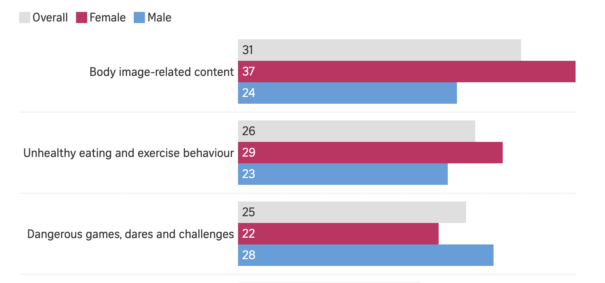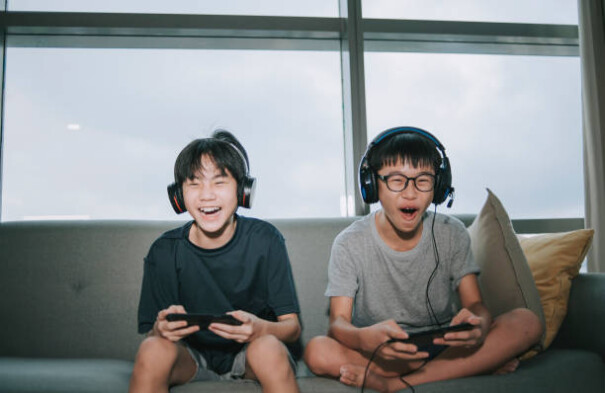Doomscrolling TikTok and binge-watching Netflix shows have become the new lifestyle for many Singaporeans since the Covid era. The acceleration of digitalisation has ramped up our reliance and addiction to digital devices and young children are no exception to this.
How social media has shifted our content exposure
In February 2024, an online study was conducted with 500 respondents between the ages of 16 and 35. The data revealed that dangerous games, dares and challenges were ranked third highest in unsolicited sensitive content young people come across.

This meant that even if someone didn’t actively search for violent content, the algorithm could recommend it to them on their feed. A male respondent shared about a livestream that appeared on his feed where two boys in China had their arms hacked off. He mentioned, “I don’t watch violent content on these platforms since I stick to funny, PG (Parental Guidance) topics most of the time. When this video was recommended in my feed, it was quite horrifying for me.” Young people who mindlessly roam the online world would certainly come across content that exposes them to some form of violence.
What about those who consciously engage in violent video games?
Gamers will probably be familiar with popular video games like Valorant, Apex Legends and Call of Duty.

The latter, Call of Duty is one of the most popular and influential video game franchises in the world. The game is known for its realistic depictions of warfare and combat scenarios and features immersive first-person views of intense, violent gameplay. Prolonged exposure to the game may blur the lines between reality and fiction, making it hard to detach from the violent nature of the scenes, especially since the player plays in a first-person perspective and aims to kill as many enemies as possible.
What do the experts have to say?
Experts have suggested that violent video games can impact a person’s aggressive thoughts, feelings and behaviour in real life.
In 2019, the Christchurch shootings demonstrated elements highly similar to playing a first-person-shooter video game, where it marked the deadliest terrorist attack in New Zealand’s history.
28-year-old Brenton Tarrant, fatally shot 51 people in two mosques in Christchurch.
He portrayed himself as a hero, “I am just a regular white man from a regular family who decided to take a stand to ensure a future for my people.” as he outlined the motivation and narrative for the attack. He was live streaming on Facebook using a GoPro camera mounted to his helmet, similar to First-Person Shooter games. The use of multiple weapons and the drive to the second location showed parallels with games like Grand Theft Auto.
The attack was also discussed on the imageboard 8chan, where users commented and interacted, similar to online gaming scenarios. Gaming cultural references, such as “Press F to pay respects” were also used in the thread. The attacker’s actions and the online discussion surrounding the attack demonstrate a disturbing connection between violent extremism and gamification.
Being inspired by murder, gory or torture scenes in movies echoes the above example as well. Murderers have confessed to modelling their crimes on serial killers from films or television. In 2004, Michael Hernandez stabbed a friend 40 times, imitating killings he had seen in American Psycho (2000) and The Silence of the Lambs (1991). The long-standing debate on whether consuming violent content in media can lead to the normalisation of violence is multi-layered and complex.

Despite compelling research, there has been no significant data that suggests that films and gameplays have a direct influence on making one more immune to violence.
More often than not, gamers and film watchers appreciate the occasional violence as an artistic expression and development of a more immersive narrative. An experiment done to understand this by Raul Ramos revealed that participants felt more empathy toward victims of real-life violence than those of fictional movie violence even after consuming violent content.
It is also a question of nature and nurture on one’s inclination to violence. Most of us are guided by an inner moral compass and witnessing fictional violence is different from engaging in violent acts in real life. Engaging in violent acts can even be a deterrent for future acts of violence because of traumatic it can be, as any soldier will tell you. Post-traumatic stress disorder (PTSD) affects up to 18% of combat veterans, many of whom will seek care from clinicians outside the military healthcare system.
Though most people can separate fantasy from reality, young children are more susceptible to imitating violent acts especially with realistic and repeated exposure to violence in media. It can heavily influence their thoughts and heighten their aggression.
What can we do?
Navigating the landscape of violent media requires mindfulness and the active choice of whether to partake in violent content or entertainment.
While we have personal freedom, we should be aware that it still requires a level of self-discipline. For young children who are highly impressionable, parental supervision is paramount.

It is natural for parents to want to protect their child. This instinct should be extended to the Internet, as their lives become increasingly entangled in it and a good way to start protecting children is by inculcating healthy Internet habits from a young age. Parents can restrict the content viewing for kids on Netflix and YouTube to protect the media they watch and reduce screen time and accessibility to gaming in their formative years.
For grown ups, we have a collective responsibility to foster a culture of empathy and understanding. This begins with our individual choices and actions, as we choose how we engage with media critically and interact with others. By being aware of our own biases and actively seeking diverse perspectives, we can cultivate a more compassionate and inclusive community.
Let us strive to be discerning media consumers and work together to build a society that values empathy, kindness, and respect for all.
